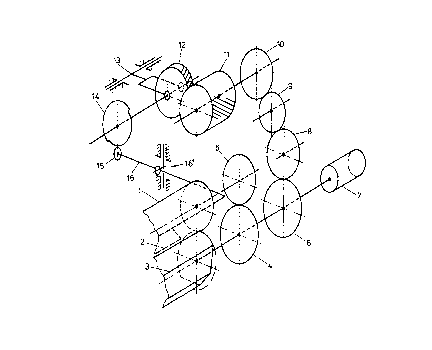Some of the information on this Web page has been provided by external sources. The Government of Canada is not responsible for the accuracy, reliability or currency of the information supplied by external sources. Users wishing to rely upon this information should consult directly with the source of the information. Content provided by external sources is not subject to official languages, privacy and accessibility requirements.
Any discrepancies in the text and image of the Claims and Abstract are due to differing posting times. Text of the Claims and Abstract are posted:
| (12) Patent Application: | (11) CA 2306951 |
|---|---|
| (54) English Title: | SCREEN PRINTING INSTALLATION |
| (54) French Title: | GROUPE DE SERIGRAPHIE |
| Status: | Deemed Abandoned and Beyond the Period of Reinstatement - Pending Response to Notice of Disregarded Communication |
| (51) International Patent Classification (IPC): |
|
|---|---|
| (72) Inventors : |
|
| (73) Owners : |
|
| (71) Applicants : |
|
| (74) Agent: | ROBIC AGENCE PI S.E.C./ROBIC IP AGENCY LP |
| (74) Associate agent: | |
| (45) Issued: | |
| (86) PCT Filing Date: | 1998-08-26 |
| (87) Open to Public Inspection: | 1999-04-22 |
| Examination requested: | 2003-07-22 |
| Availability of licence: | N/A |
| Dedicated to the Public: | N/A |
| (25) Language of filing: | English |
| Patent Cooperation Treaty (PCT): | Yes |
|---|---|
| (86) PCT Filing Number: | PCT/CH1998/000368 |
| (87) International Publication Number: | WO 1999019146 |
| (85) National Entry: | 2000-04-12 |
| (30) Application Priority Data: | ||||||
|---|---|---|---|---|---|---|
|
The invention relates to a screen printing installation having a round screen
(1) with a squeegee (2) and a counterpressure surface (3) fitted inside. Said
installation has a device which is synchronized with the screen drive (1) and
the counterpressure surface (3). This device controls the lifting off of the
squeegee (2), and has at least one cam (14) which moves the squeegee (2) into
the desired position by means of a squeegee lever (16).
L'invention concerne un groupe de sérigraphie comprenant un écran rond (1), dans lequel est disposée une racle (2), et une surface de contre-pression (3). Ledit groupe comporte un dispositif synchronisé avec le dispositif d'entraînement de l'écran (1) et de la surface de contre-pression (3), qui sert à l'élévation commandée de la racle (2) et présente au moins une came (14) qui met la racle (2) dans la position souhaitée, par l'intermédiaire d'un levier de racle (16).
Note: Claims are shown in the official language in which they were submitted.
Note: Descriptions are shown in the official language in which they were submitted.

2024-08-01:As part of the Next Generation Patents (NGP) transition, the Canadian Patents Database (CPD) now contains a more detailed Event History, which replicates the Event Log of our new back-office solution.
Please note that "Inactive:" events refers to events no longer in use in our new back-office solution.
For a clearer understanding of the status of the application/patent presented on this page, the site Disclaimer , as well as the definitions for Patent , Event History , Maintenance Fee and Payment History should be consulted.
| Description | Date |
|---|---|
| Application Not Reinstated by Deadline | 2006-08-28 |
| Time Limit for Reversal Expired | 2006-08-28 |
| Letter Sent | 2005-12-21 |
| Deemed Abandoned - Failure to Respond to Maintenance Fee Notice | 2005-08-26 |
| Inactive: Office letter | 2005-01-11 |
| Letter Sent | 2003-08-21 |
| Request for Examination Received | 2003-07-22 |
| All Requirements for Examination Determined Compliant | 2003-07-22 |
| Request for Examination Requirements Determined Compliant | 2003-07-22 |
| Letter Sent | 2000-10-06 |
| Inactive: Single transfer | 2000-08-31 |
| Inactive: Cover page published | 2000-06-21 |
| Inactive: First IPC assigned | 2000-06-14 |
| Inactive: Courtesy letter - Evidence | 2000-06-13 |
| Inactive: Notice - National entry - No RFE | 2000-06-06 |
| Application Received - PCT | 2000-06-05 |
| Application Published (Open to Public Inspection) | 1999-04-22 |
| Abandonment Date | Reason | Reinstatement Date |
|---|---|---|
| 2005-08-26 |
The last payment was received on 2004-08-04
Note : If the full payment has not been received on or before the date indicated, a further fee may be required which may be one of the following
Please refer to the CIPO Patent Fees web page to see all current fee amounts.
| Fee Type | Anniversary Year | Due Date | Paid Date |
|---|---|---|---|
| Basic national fee - standard | 2000-04-12 | ||
| MF (application, 2nd anniv.) - standard | 02 | 2000-08-28 | 2000-08-03 |
| Registration of a document | 2000-08-31 | ||
| MF (application, 3rd anniv.) - standard | 03 | 2001-08-27 | 2001-07-12 |
| MF (application, 4th anniv.) - standard | 04 | 2002-08-26 | 2002-08-09 |
| Request for examination - standard | 2003-07-22 | ||
| MF (application, 5th anniv.) - standard | 05 | 2003-08-26 | 2003-07-24 |
| MF (application, 6th anniv.) - standard | 06 | 2004-08-26 | 2004-08-04 |
Note: Records showing the ownership history in alphabetical order.
| Current Owners on Record |
|---|
| GALLUS FERD.RUESCH AG |
| Past Owners on Record |
|---|
| HANSRUDOLF FRICK |
| HEINZ BROCKER |